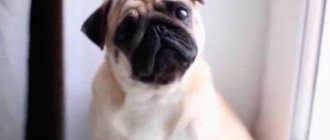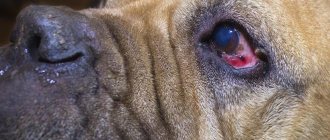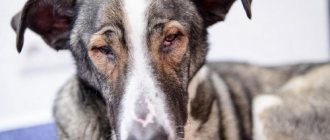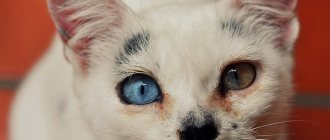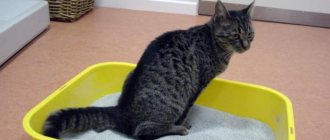Symptoms
Proptosis is a pathological forward displacement of the eyeball. The following symptoms indicate a problem:
- the eye looks hypertrophied and bulging;
- the conjunctiva turns red and swells;
- a small amount of blood may be released;
- the animal blinks frequently, squints and cannot tolerate bright lighting;
- the cornea dries out and looks matte;
- there is weakness and decreased activity due to pain.
Often this phenomenon progresses gradually, so it can be noticed at the initial stage; it is only important to carefully monitor the pet’s appearance. The development of pathology is judged when the white of the eye becomes covered with red streaks and moves slightly forward.
Causes
A predisposing factor to eye loss is the brachycephalic structure of the skull bones, which is determined anatomically. These dogs are characterized by a flattened muzzle, a wide palpebral fissure, a raised nose and round, protruding eyes. This includes breeds such as Pekingese, Shar Pei, Chihuahua, Shih Tzu, Pug, English Bulldog, Japanese Chin, and Bullmastiff.
A dog's eyes fall out for one of the following reasons:
- excessive load;
- trauma, blow, especially to the temple area;
- hydrocephalus;
- high intracranial pressure;
- tumor.
Diseases are less likely to provoke this phenomenon than mechanical effects.
Reasons why dogs lose eyes
This problem in animals can arise due to the following factors:
- Advanced ophthalmological diseases, which are accompanied by weakening or deformation of the muscles of the eyeball.
- Sudden jumps made by a pet.
- Falls from the sofa, chair.
- Getting caught in the corner of an open door with subsequent pinching of the neck or head.
- Eye injuries - abrasions, scratches, cuts.
- Wearing an excessively narrow collar, strong leash tension. The dog owner needs to remember that there should be a distance of at least one finger between the neck accessory and the pet’s skin.
- Stress. In some breeds, eye loss can occur due to fear.
- Injuries to the cervical spine (including injuries sustained when lifting a dog by the scruff of the neck) or the temporal part of the skull.
- Diseases, including infectious diseases accompanied by high fever.
- Insect bites.
The factors presented can lead to eye loss in a dog of any breed. It is extremely important for the animal owner to pay attention to this problem in a timely manner, immediately provide first aid and visit a veterinarian to undergo a full examination and receive the necessary treatment.
Is it possible to straighten the eye yourself?
If a dog's eye has fallen out, it is contraindicated to return it to its natural position on your own; this should only be done by a veterinarian. Before taking your pet to the clinic, it is recommended to take a number of actions:
- Rinse the eye with saline and artificial tears or plain water, brought to a boil and cooled. This can be done by douching or using a soft cloth or gauze. Cotton wool products should not be used as the lint will cause further irritation.
- Cold must be applied to the swollen area around the affected organ, without touching the cornea. To make a compress, pieces of ice are covered with plastic film, wrapped in cloth and applied for 10 minutes to eliminate swelling and bleeding.
- Then oletethrin, hydrocortisone, tetracycline ointment or a special moisturizing gel is applied to the affected area.
- To prevent the dog from injuring the eye, a protective collar is put on it.
These actions are designed to alleviate the pet’s condition and reduce the risk of further displacement of the eyeball. It is prohibited to treat the visual organ with liquids containing alcohol, hydrogen peroxide, chlorhexidine and other antiseptic substances. This will cause the mucous membrane to dry out even more, and irritation and discomfort will increase. Before going to the veterinarian, it is not recommended to feed your pet or give painkillers. It is necessary to take the dog to the hospital immediately after providing first aid. Delay can lead to consequences such as inflammation, purulent lesions, drying of the cornea, retinal detachment, rupture of the optic nerve and eye muscles. In severe cases, it may be necessary to completely remove the organ of vision. If a dog has a missing eye, treatment should be carried out in a clinic setting.
Reduction of the eye and suturing of the eye muscles is performed under general anesthesia. If necessary, the eyelids are also sutured. Then the manipulation area is treated with ointment, bandaged, and a collar is put on the animal. Sutures are usually removed after a week, and the doctor may prescribe antibiotics for this entire period. After 2-4 weeks, complete recovery of the eye muscles usually occurs.
First aid
It is important to properly provide first aid to a dog whose eye has fallen out in order to preserve its vision. One of the main conditions is for the owner to maintain self-control. Proptosis is not a sight for the faint of heart, but the pet should feel the confidence and calm of its owner; this will make it much easier for him to survive stress and pain. It is necessary to take the animal to the veterinarian as quickly as possible, but if you can get to the clinic no earlier than half an hour after the injury, first aid should be provided at home.
Algorithm of actions in case of eyeball loss:
- If possible, calm the dog and place a protective plastic collar around its neck. This will prevent your paws from touching the sore spot.
- Rinse the wound with water at a comfortable temperature, and then clean it of blood.
- Apply ice to the damaged area. A cold compress that relieves swelling should be left for no more than 10 minutes near the injured eye.
- Cover the eye itself with a clean napkin, cotton scarf or bandage and moisten it with saline solution. It is important to ensure that the bandage does not dry out and periodically moisten it.
- Take your pet to the veterinary clinic.
Important! It is strictly not recommended to try to straighten a dog's eye on your own.
In the case of proptosis, the critical period is the first 24 hours. If qualified assistance is not provided during this period, serious complications may develop from retinal detachment to loss of vision (in full or in part).
Prevention
Since the problem of eyeball prolapse occurs in dogs of brachycephalic breeds, they should be treated with extreme caution:
- It is necessary to protect your pet from head injuries that they can receive from hitting a door or falling from a sofa.
- Also, you should not lift the dog by the scruff of the neck so that the skin on the skull is not stretched.
- Owners of breeds predisposed to this problem should always have on hand means to provide first aid to the animal.
To prevent the problem, in some cases they resort to plastic surgery of the eye angle, but it does not provide a 100% guarantee.
List of breeds that exhibit proptosis
Dogs that are most prone to eyeball loss include the following:
- bulldogs;
- Pekingese;
- bullmastiffs;
- pugs;
- Shih Tzu;
- Japanese chins;
- chihuahua;
- boxers;
- Petit Brabançons;
- Boston Terriers;
- Shar-Pei.
Photo gallery: dogs with a predisposition to developing proptosis
Boston Terriers are very active when walking, so in the summer you need to make sure that they do not overheat
The Brabançon was created by crossing a spaniel and a pug.
Boxers are hardy and strong dogs; because of these qualities they are often used in police and security
The Chihuahua is the most popular dog breed in Hollywood.
The Japanese Chins, who lived at the imperial court, had their own personal servants and doctors
This breed almost never barks as an adult, only occasionally you can hear some quiet, restrained sound from it.
In the 18th century, pugs were considered a purely female dog.
For many years, a bullmastiff named Gunner was a kind of mascot of the English football team Arsenal.
Shar Pei means "sand skin" in Chinese.
This breed of dog is susceptible to skin diseases, allergies, urolithiasis, they have entropion of the eyelid, and also have difficult childbirth
When the Titanic sank, only three dogs survived the ship, one of which was a Pekingese.
The dog's eye fell out: causes and first aid
- Enophthalmos is a displacement of the eye towards the orbit. The size of the eyeball remains the same; it seems to go deeper into the orbit;
- Microphthalmos – reduction in the size of the eyeball;
- Exophthalmos of the second eye - protrusion. In this case, it is possible to mistakenly assume that the healthy eye is “retracted”;
- Anophthalmos is a congenital absence of the eye, sometimes owners confuse it with microphthalmos;
According to the nature of occurrence and duration of the flow, they are divided into:
- Congenital, chronic eye diseases;
- Acute, acquired;
- Chronic, acquired;
How to fix your eye yourself
If the eyeball has not completely fallen out, and no more than 15 minutes have passed since the injury, you can help the dog yourself. The procedure algorithm is not complicated:
- Wash your hands with soap and moisten them with antiseptic.
- Treat your eye with an antiseptic solution.
- Use one hand to open the dog's eyelids.
- Use your second palm to press the eyeball through a clean napkin.
- When realigned, you will hear a characteristic click.
- Cover your eye with a clean cloth soaked in saline solution.
- Take your dog to the vet.
Treatment of eye retraction and cost of going to the clinic
In acute inflammatory diseases or eye injuries, treatment is most often aimed at eliminating inflammation. Local anti-inflammatory and antibacterial drops are prescribed (price from 200 rubles), followed by monitoring the animal’s condition. In chronic pathologies, treatment is usually aimed at preserving the eye and reducing the rate of development of shrinkage/retraction of the eyeball. In any case, it is important to identify the underlying cause, and the doctor will select an individual treatment plan and the approximate cost of drugs and services, taking into account your capabilities and wishes.
We work for you 24 hours a day, 7 days a week. We are located at:
Krasnoyarsk, Partizana Zheleznyaka str. 9g; +7 (391) 2-179-779
Treatment of proptosis for eye loss in dogs
What to do if your dog's eye falls out? When faced with such a phenomenon for the first time, the animal owner panics. Meanwhile, proptosis in dogs is a fairly common phenomenon.
Various injuries and pathologies of the visual organs in dogs are common. A special category is an anomaly characterized by prolapse of the eyeball. There are several breeds, due to a certain structure of the skull, that are predisposed to this pathology. What kind of breeds are these, why is proptosis characteristic of them, what to do in case of eyeball loss?
About the disease
Loss of the eyeball is a consequence of injuries or excessively active games, fights between animals. Under the influence of a traumatic factor, the eyeball falls out of the orbit and is pinched by the eyelids. Proptosis can also be caused by some ophthalmological diseases that cause muscle weakness. In theory, the owner of any dog can face this problem. But it is most likely to occur in brachycephalic breeds, which are characterized by a shortened facial skeleton and bulging eyes.
The main causes of eyeball prolapse
Proptosis (proptosis in Greek means “falling forward”) is a forward displacement of an organ or part of it, the so-called prolapse of the eyeball. The protrusion occurs due to strong physical exertion or some kind of injury - bruise, blow. Blows to the temporal region are especially dangerous. These are external causes of the manifestation of the disease.
Internal factors of proptosis include increased intracranial pressure and other post-ocular processes, under the influence of which the eye seems to be squeezed out from the inside. But the most common reason why a dog’s eyes fall out is, nevertheless, mechanical impact.
Dog Breeds Affected by Proptosis
Any animal can get injured, resulting in a fall of varying severity. However, brachycephalic dogs are most susceptible to this pathology. Animals with a shortened muzzle are called brachycephalic. In addition to snub nose, brachycephalics are distinguished by a flattened head shape and large bulging eyes - the so-called pop-eyedness. The structure of the orbits in the brachycephalic type is characterized by an extremely shallow bed and shortened muscles. The organ of vision is supported in its orbit, to a large extent, by the eyelids. They are also at risk of problems with the third eyelid.
What breeds of dogs have eyes that fall out?
Eye loss should not be taken literally. Your dog's eye won't fall out and roll on the floor. Prolapse means too much “protrusion” of the eye from the socket, which can cause many unpleasant consequences for your pet.
Eyeball prolapse is the prerogative of dogs with a shortened skull and a slightly raised nose. Representatives of small breeds are also susceptible to this disease.
Most often, Chihuahuas, Pekingese, Japanese Chins, Bulldogs, Boxers, Bullmastiffs, Shih Tzus, Shar Peis, Pugs and Boston Terriers are at risk of eyeball loss.
The severity of damage to the organ of vision is influenced by the individual reaction of the body and the length of time after damage
First aid
If proptosis is detected in your pet, you should immediately go to the veterinary clinic. It is absolutely forbidden to correct a prolapse on your own! Before going to the clinic, you need to take a number of sanitary and preventive measures in order to alleviate the condition of your pet and minimize, as far as possible, the consequences of vision loss.
So, what immediate measures can the owner take on his own?
— First of all, carefully rinse the injured organ with saline solution (sodium chloride), a natural substitute for tear fluid (sold in pharmacies) or boiled water. Under no circumstances should you use antiseptics (hydrogen peroxide, chlorhexidine, etc.) or alcohol-containing solutions!
— Apply a cold compress for ten minutes, but not on the apple itself, but on the swollen areas around it. This is done in this way: put pieces of ice from the refrigerator in a plastic bag, wrap it with a cloth on top, and apply it to the swelling without touching the open cornea. Do not hold ice for longer than 10 minutes to avoid tissue hypothermia!
— Rinse should be done by careful douching or a piece of cloth (gauze, bandage, cotton material) generously moistened in saline solution. It is strictly forbidden to use cotton wool, cotton swabs or pads! Villi can get on the injured cornea, aggravating the already deplorable condition of the animal with unnecessary discomfort.
- Generously lubricate the wound with a special ointment (ditetracycline, oletethrin, hydrocortisone).
Having carried out all these manipulations, you should exclude the possibility of the animal touching the injury (put on a hard tube collar) and go to the clinic. Of course, it is necessary to see a doctor as soon as possible after receiving an injury that caused proptosis.
What to do about it
Surgery for this disease is a mandatory component of treatment
First of all, you need to know how to help your dog before going to the vet:
- The owner must remain calm. Your pet already understands that everything is bad, so you shouldn’t panic to make the situation worse.
- Calm your pet and put a protective collar on him to prevent his paws from touching the injury.
- Rinse the wound with water (at a comfortable temperature) and clean it of blood stains.
- Apply a cold compress to the sore area, which should relieve swelling. You need to keep it for no more than 10 minutes near the injured organ of vision.
- Cover the injury with a clean bandage or bandage soaked in saline solution. Do not allow the bandage to dry out; moisten it constantly.
- Go to the vet immediately
When the eyeball falls out, the critical period is a day. Further, the pathology will develop into serious consequences, including retinal detachment and complete loss of vision. At the veterinary clinic, the pet will undergo restorative surgery, during which the doctor will trim part of the eyelid and return the organ to its correct position in the eye socket.
Urgent medical care and treatment
If you do not visit a doctor in a timely manner, secondary phenomena develop in the injured organ, such as severe inflammation, suppuration, and drying out of the cornea. This is fraught with fatal consequences. The protruding eye is supported only by the rectus externus muscle, and is pinched by the eyelids. If the optic nerve ruptures, then, most likely, the function of the damaged eye will not be restored - the prognosis is disappointing, including removal.
After an initial examination of the injured pet, the veterinarian, under anesthesia, sets the missing eye, sutures the muscles and partially (or temporarily completely) the eyelids, and applies a bandage. To prevent the dog from rubbing the muzzle, wear a high, hard collar. Throughout the postoperative period, until the sutures are removed, sanitary and hygienic treatment and other procedures are carried out:
- washing with saline solution;
- applying special eye ointments;
- drug therapy (injections, tablets).
The sutures are removed after about a week (the attending physician will tell you more precisely). Continued medical care may be required for some time after the sutures are removed.
Forecasts
After the operation, you should protect your pet from physical exertion, from falls, from conflict situations with other animals, and from active games. Please remember that the injury may recur.
We can talk about the best prognosis only if there is a minimum period of time from the injury to the visit to the clinic. It is impossible to guarantee one hundred percent return of vision after a lesion, but the risk of complications up to the complete loss of the ability to see is real.
Complications after surgery are:
- strabismus (corrected by filing the eyelids);
- corneal sensitivity disorder and keratoconjunctivitis (insufficient hydration);
- atrophy of the eyeball (the organ must be removed);
- non-closure of eyelids.
If your dog's eyes are falling out or there is a risk of developing proptosis, cosmetic surgery to close the eyelid incision can minimize the threat. Knowing about this peculiarity of your pet’s breed, you should protect it as much as possible from possible traumatic situations.
Treatment of the disease
If a bulldog, Pekingese or pug has lost eyes, he is scheduled for surgery. Since it is performed under general anesthesia, it is recommended not to feed the dog before visiting the veterinarian. Surgical treatment of a dog is carried out as follows:
- The pet is given anesthesia and waited for it to take effect.
- After this, the affected eye is cleaned of dirt and fluid that accumulates due to inflammation. If there are wounds on the animal’s face, they are also treated with antiseptic drugs.
- Part of the eyelid is trimmed, a hydrocortisone solution is injected, and the eyeball is set.
- The eyelid is strengthened with supporting sutures.
After the operation is completed, a protective bandage soaked in antimicrobial ointment is applied to the dog's eye. The stitches are removed after a week. Complete recovery of the eye muscle takes from 15 days to a month. During this period, you need to provide good care for your pet, complete rest, and protect it from contact with other animals. You should visit the veterinarian several times after the operation. The doctor will have to change the bandage, administer anesthetics and make sure that the animal does not develop complications.
In most cases, the prognosis for this disease is positive. If the owners of a pug or bulldog did not go to the clinic in a timely manner and the eyeball was severely damaged, it can be removed.
Video: Which dogs have eyes that fall out? Causes and treatment of pathology
Eyeball prolapse in dogs
Dogs are amazing animals. Their peculiarity is not only in their devotion, intelligence, and friendly character, but, unfortunately, also in some of the diseases that they suffer from.
For example, did you know that there is a breed that loses its eyes? These are Shih Tzu dogs that have such an unusual pathology. This type of problem can happen to any dog, but some breeds are more prone to this disease. For owners whose pets are at high risk, it is especially important to have maximum information about this problem and be able to navigate in an extreme situation.
Causes and symptoms of eyeball prolapse
A dog’s eyes fall out if it finds itself in a situation that provokes the occurrence of such a pathology:
- a blow to the neck or head from the side or from above;
- lifting and carrying the animal by the skin of the withers.
As a result of such mechanical action, the eyeball shifts and extends beyond the eyelid that holds it. The loss can be complete or partial.
After an injury, the dog experiences a feeling of pain and discomfort, accompanied by the following signs:
- excessive protrusion of the eyeball;
- bloody discharge from the eye;
- increased blinking of the eyes;
- drying and dullness of the cornea;
- swelling of the conjunctiva;
- fear of light;
- animal depression.
Such symptoms will not go unnoticed by the dog owner, so you need to try to help the pet before arriving at the veterinary clinic.
Eye injuries
Any eye injury is very serious, regardless of what caused it. In breeds with protruding eyes (pugs, bulldogs, Pekingese, Yorkshire terriers, etc.), due to breed characteristics, injuries occur more often, and the inflammatory process is more pronounced. Key signs of eye injury in a pet may include:
- prolonged squinting;
- discharge from the eye of fluid with bloody inclusions, transparent or containing pus;
- changed behavior of the dog (usually the dog does not allow you to touch its face, whines, may bite when the owner tries to touch the injured eye, etc.);
- loss of transparency of the cornea, the appearance of whitish, bluish-tinged or bloody spots on it.
So-called contusion injuries, which develop as a result of an impact to the eyes, can also pose a danger to the pet’s vision, which often leads to retinal detachment or rupture, intraocular hemorrhages, including swelling of the optic nerve. Moreover, unlike external ones, internal damage of this kind can remain unnoticed by the animal owner for a long time. The possibility of vision restoration is directly dependent on the timing of receiving the necessary medical care. Therefore, if you have any alarming symptoms, you should take your pet to the veterinarian.
How to help a dog?
The sight of a dog losing an eye is, of course, not for the faint of heart, and therefore the owners, in fright, forget how to help their pet, but they need to gather their will into a fist and begin to act:
- First, you need to protect the affected eye from any touch to it. To prevent the dog from touching or scratching it with its paws, it is better to put a special collar on it or carefully monitor the animal’s behavior.
- Using a clean bandage (preferably sterile), moistened with cool boiled water or saline, remove dirt and blood from the wound with blotting movements. Do not use cotton wool or cotton pads, particles of which will stick to the eyeball, or any antiseptic solutions - hydrogen peroxide, alcohol-containing liquids, etc.
- Apply eye ointment carefully.
- To relieve swelling, apply cold to the eye for 10-15 minutes.
- Cover the affected eye with a clean, damp cotton cloth.
After providing first aid, you should immediately go to the veterinarian, and under no circumstances should you try to straighten the eye yourself, as such actions can lead to very serious consequences!
If a dog’s eye falls out and it was provided with unqualified help or treatment was started very late, then in the future the animal will have serious problems with vision:
- due to stretching of the optic nerve or its rupture, its connection with the central nervous system may be disrupted, which leads to loss of vision;
- rupture of the retina leads to atrophy of the eyeball and, as a result, the dog faces blindness;
- corneal injury causes cataracts, increased intraocular pressure, and decreased visual acuity;
- Violation of the integrity of the eye muscles in dogs causes strabismus.
Preventive measures
The Shih Tzu breed is characterized by shallow eye sockets, which is why the dog's eyes fall out due to head injuries. Prophylactic plastic surgery, during which the palpebral fissure is sutured, helps prevent proptosis. The operation can be done only after the dog reaches maturity, after one year of life.
The injury is more often complicated by proptosis if the dog’s eyes are inflamed at this moment. Therefore, after each walk, it is necessary to inspect the animal’s eyelids, remove dirt, natural secretions, and particles of foreign objects with a clean cloth. For daily care, use sterile saline solution, and if an inflammatory process occurs:
- chamomile decoction;
- furatsilin solution;
- potassium permanganate solution.
The Shih Tzu is a dog whose eyes require constant care. To preserve their health, do not walk your pet on a leash (only on a harness). Do not allow him to run in the sand, in tall grass, or on a dusty road. Hide household chemicals in an inaccessible place, remove the bed from a draft. Do not allow your pet to interact with stray and sick dogs, or with unfamiliar children who could hit the dog.
Treatment for eye loss in dogs
This pathology cannot be treated therapeutically, so your pet will undergo surgery, as a result of which the prolapsed eye will be put in place.
The surgical intervention takes place under general anesthesia and has several stages:
- Removing contamination from the eye by rinsing with 1 percent dioxidine and novocaine.
- Injection of a hydrocortisone solution into the eye and dissection of the eyelid adhesions.
- Return the eyeball to its place with a sterile napkin lubricated with eye ointment with an antibiotic.
- Applying another antibacterial ointment and a fixing bandage to the operated eye.
After surgery, antibiotics are recommended for a week. After this period, the eye is re-treated with antimicrobial ointment and painkillers. The final date for removing the bandage will be determined by the veterinarian based on his observations.
The eye muscles return to normal completely after one to two months. If you rush to remove the stitches or do not follow the doctor’s recommendations, then the dog may still have eye problems, manifested by corneal ulceration, strabismus, cataracts, etc.
Prevention
Many owners of at-risk dogs ask how to prevent their pets from losing their eyes. First of all, you need to handle the animal as carefully as possible - do not throw it, do not play dangerous games, protect it from too active games with children, do not pick it up by the withers.
While walking, try to protect the dog from communicating with too large relatives and monitor its movements.
Veterinarians also suggest that puppies undergo preventive eyelid surgery, during which the size of the palpebral fissure is reduced, which reduces the risk of proptosis.
If you decide to get a miniature dog, then take into account some of the features of their health related to their body structure, be prepared for unexpected “surprises” and just love your little friend!
